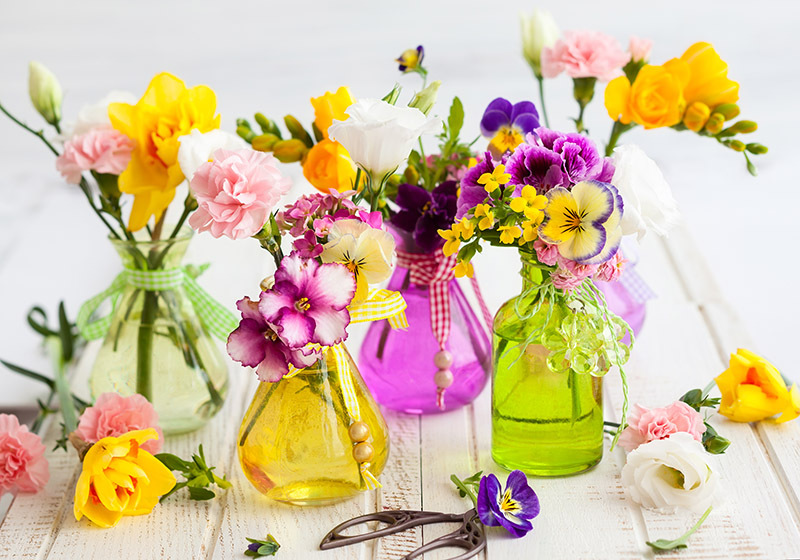8 Unexpected Facts About Sunflowers You Need to Know
Posted on 29/08/2025
8 Unexpected Facts About Sunflowers You Need to Know
Sunflowers are among the most recognizable and beloved flowers in the world, brightening gardens, fields, and homes with their radiant blooms. While you may associate sunflowers with sunny days and tasty seeds, there's much more to these remarkable plants than meets the eye. Whether you're a gardening enthusiast or just a curious reader, here are 8 unexpected facts about sunflowers that will change the way you see these sunny giants.
1. Sunflowers Track the Sun, but Not Forever
One of the most iconic features of sunflowers is their ability to follow the sun, a phenomenon known as heliotropism. As the sun moves across the sky, young sunflower buds and leaves turn their faces to follow it from east to west during the day.
- Heliotropism occurs mainly in the bud stage. Mature blooms typically face east and stop following the sun.
- This movement helps the plants optimize photosynthesis, capturing as much sunlight as possible during critical growth periods.
- Scientists have found that the inner clock in young sunflowers resets each night, allowing them to face east every morning.
Interestingly, once the sunflower matures, it usually stops moving and remains facing east. Why? Facing east helps the flower warm up more quickly in the morning, which attracts pollinators and boosts reproduction.

2. The Largest Sunflower Ever Grown Was Record-Breaking
Many people are surprised to learn how tall these flowers can actually get. The official record for the tallest sunflower belongs to Hans-Peter Schiffer from Germany, who grew a sunflower that reached an astounding 30 feet 1 inch (9.17 meters) in 2014.
- Most garden sunflowers reach heights between six and 10 feet, depending on the variety.
- There are also dwarf sunflower types that only grow two to three feet tall, making them ideal for small spaces and container gardening.
- Giant sunflower varieties continue to fascinate gardeners who engage in friendly competitions every year.
These towering sunflowers require a lot of sunlight, water, and support, often being staked to prevent collapse. Their impressive height reflects both their adaptation skills and the dedication of their growers.
3. The Sunflower Family Includes Over 70 Species
When most people think of sunflowers, they imagine the single, large yellow bloom of Helianthus annuus, the common annual sunflower. However, the sunflower genus (Helianthus) is much larger than you might expect.
- There are over 70 species in the sunflower family, including perennial types that come back year after year.
- Helianthus tuberosus, better known as Jerusalem artichoke or sunchoke, is a sunflower that produces edible tubers instead of seeds.
- Some species bloom with white, red, or even purple petals.
This diversity supports a wide range of wildlife and garden uses, from ornamental planting to food production. Whether you want to plant giant sunflowers for a dramatic effect or cultivate perennials for low-maintenance beauty, the sunflower family has something for everyone.
4. Sunflowers Have Been Cultivated for Thousands of Years
One of the lesser-known facts about sunflowers is their ancient history. Archaeological evidence suggests that sunflowers have been domesticated since around 3,000 BC, making them one of the oldest known cultivated crops in North America.
- Native American tribes valued sunflowers as a source of food, oil, dye, and medicine.
- Sunflower seeds were ground into flour, pressed for oil, and used in ceremonial body paints and textiles.
- Today, sunflowers remain vital, serving as an important crop in regions worldwide.
Sunflowers were even seen as spiritual symbols, representing the sun and its life-giving power. Their ability to thrive in different environments and their many uses ensured their spread across continents, making sunflowers an enduring part of agricultural and cultural history.
5. Wildlife and Pollinators Love Sunflowers
Sunflowers are not just a pretty face in the garden--they're a beacon for wildlife and beneficial pollinators. Their bright yellow petals and abundant pollen attract bees, butterflies, and birds, making sunflowers a key player in a healthy ecosystem.
- Bees and other pollinators feed on sunflower nectar and help fertilize the flowers, increasing seed production.
- After blooming, the flower heads are packed with seeds, which are a favorite food for local birds, such as goldfinches and sparrows.
- Sunflowers can even serve as natural pest repellents, attracting insects that prey on broccoli and other vegetable pests.
By growing sunflowers, you not only brighten your landscape but also support vital pollinators and local wildlife.
6. Sunflower Seeds: A Nutritional Powerhouse
When most people think of sunflowers, they might picture the large, seed-filled heads. But did you know that sunflower seeds are among nature's most nutritious snacks? These seeds are packed with vitamins, minerals, healthy fats, and protein--making them a favorite among health enthusiasts.
- Sunflower seeds are an excellent source of Vitamin E, Magnesium, and Selenium.
- They contain healthy unsaturated fats that can support heart health.
- Contribute to energy production, skin health, and immune system function.
- Sunflower seeds can be eaten raw, roasted, sprinkled on salads, or ground into sunflower butter for a tasty peanut butter alternative.
Not only are sunflower seeds delicious, but they're also versatile in the kitchen and provide a wide range of health benefits.
7. Sunflowers Can Help Clean Contaminated Soils
Here's an unexpected fact about sunflowers that may surprise you--sunflowers possess phytoremediation abilities. This means they can be used to clean up soil that's been contaminated with toxic substances like heavy metals and radiation.
- After nuclear disasters such as Chernobyl and Fukushima, sunflowers were planted to help absorb radioactive materials from the soil and water.
- Sunflowers' deep root systems act as natural sponges, drawing up lead, arsenic, and other contaminants.
- This eco-friendly cleanup method demonstrates sunflowers' value beyond beauty or harvest.
Phytoremediation is an emerging field, and sunflowers are at its heart. Their environmental benefits could play a significant role in future green technology and land restoration projects.
8. Sunflowers Have Inspired Art, Culture, and More
Perhaps the most famous depiction of this flower is in Vincent van Gogh's celebrated series of sunflower paintings. These iconic works shine a bright light on the role sunflowers have played in human culture throughout history.
- Sunflowers have been featured in poetry, literature, and folklore worldwide.
- The sunflower is the state flower of Kansas, earning the Midwestern state its nickname, "The Sunflower State."
- Sunflowers are a symbol of positivity, happiness, adoration, and loyalty, making them a favorite motif in art and decoration.
From ancient spiritual symbolism to the contemporary kitchen table, sunflowers have crept into every corner of creativity and culture.
Bonus: Sunflower Oil Is Big Business
Another fascinating aspect you might not know is the economic impact of sunflowers. Sunflower oil is extracted from the seeds and used extensively in cooking, baking, and food manufacturing.
- Sunflower oil is rich in vitamin E and omega-6 fatty acids, making it a popular choice for both culinary and cosmetic applications.
- Ukraine, Russia, and Argentina are among the largest producers of sunflower oil globally.
- The oil is prized for its light flavor and high smoke point, making it ideal for frying and sauteing.
Sunflower-based products contribute billions of dollars to the global economy every year, proving that these flowers are not just beautiful, but also highly valuable.
Final Thoughts: Sunflowers Are More Than Meets the Eye
From their sun-following habits to their role in environmental cleanup and art, sunflowers are truly remarkable plants. Growing sunflowers can benefit your home garden, provide food for both people and wildlife, and even inspire your creativity. Next time you pass by a field of sunflowers or snack on some seeds, remember these unexpected sunflower facts--and share them with your friends!
Key Takeaways: Uncommon Sunflower Facts
- Sunflowers track the sun as they grow but stop after maturity.
- The tallest sunflower on record towered over 30 feet.
- There are over 70 sunflower species with different colors and uses.
- Sunflowers boast an ancient heritage and a lasting role in culture and agriculture.
- They attract wildlife, provide nutrition, and help clean up polluted soil.
- Sunflower oil fuels a global industry and your kitchen adventures.

Frequently Asked Questions About Sunflowers
Are sunflowers easy to grow?
Yes, sunflowers are generally easy to grow as long as they receive plenty of sunshine and water. They're drought tolerant once established but benefit from regular watering for the best flowers and seed production.
Do all sunflowers produce edible seeds?
Not all sunflower varieties produce seeds suitable for human consumption. Ornamental varieties may have smaller or less palatable seeds, but most common sunflowers (Helianthus annuus) are grown for their edible seeds.
Can sunflowers be grown indoors?
While some dwarf varieties can be grown indoors in containers, sunflowers generally perform best outdoors with direct sunlight.
How do I harvest sunflower seeds?
Allow the flower head to dry on the stalk. Once the back turns brown and the seeds start to loosen, cut the head and rub the seeds out. Dry and store seeds in a cool, dry place.
Conclusion
Sunflowers are more than just a cheerful addition to your garden--they're botanical marvels with a fascinating history, impressive environmental uses, and endless inspiration for artists and gardeners alike. Share these crazy sunflower facts with others and see who you can surprise with your new knowledge about this incredible flower!
Latest Posts
Crafting a Lasting Display with Your Poinsettias
8 Unexpected Facts About Sunflowers You Need to Know
Tulip Tidbits: Seven Facts That Will Surprise You






